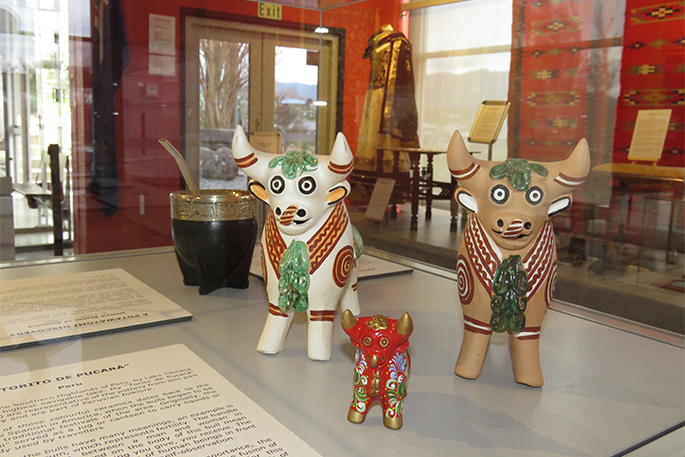Western Bay Museum’s latest exhibition ‘Treasures of Cultures’ is like a large mirror reflecting the melting pot of people and families – their cultures, stories and traditions – who live locally.
Museum manager Paula Gaelic says 30 countries and 51 objects from 41 local donors make up the exhibition – which depicts cultures from all seven of the world’s continents.
“Everything in this exhibition has come from people and families within our community,” says Paula.
Paula came up with the exhibition’s concept – then went to the community asking: ‘What did you bring with you that is important to you culturally?’
Paula says the 41 donors who have loaned items have themselves written the labels to accompany each display.
As such, stepping into the museum is like taking a trip around the world!
There’s so many items from so many parts of the world to view and learn about – and the story of how they connect to their local resident owner.
Bulls of Peru
There are Bulls of Peru, which are put over houses in that country for good luck. Arrowheads from America that could date back to 1700-1800 American Indian culture. A Mate teapot from Argentina for making herbal tea “you never wash it”.
A set of wooden clogs from the Netherlands sit beside a ‘Knipmuts of Gelderland’ – a lace bonnet.
“The bonnet is really, really old. Like every exhibition – we’re learning heaps. The little pleats at the back – how long they are represent the wearer’s status. Lace bonnets were only worn for special occasions.”
Japanese hinoki and sake cups sit beside old adornments made of ivory and bone. The Arctic Circle also features thanks to a Katikati resident who lived up the top of Canada.
“The mittens and boots – she wore these. The boots are made from seal skin, moose hide and wool,” says Paula.
Scotland features – with one tartan belonging to Western BOP deputy Mayor John Scrimgeour.
“The tartan and royal banner have very strong royal connections – these tartans were even part of Queen Elizabeth’s funeral and King Charles II’s coronation.”
Turkish cradle
A beautiful Turkish cradle belongs to Bill and Sue Sisley, who purchased it when they lived in Turkey and raised their family there.
A table from India has a great story, says Paula.
“The family believe Gandhi sat around this table...”
Katikati’s Jizzy Green grew up in South Africa in the same area Nelson Mandela was born. Her family were tobacco growers – and so a tobacco pouch and snuff bottle depict this time in her life.
There’s Welsh spoons, Fijian kava bowls, and stunning Chinese calligraphy.
“This is owned by a Chinese couple in Katikati. When they moved here the lady’s father, who has learnt calligraphy since he was a child, wrote this calligraphy for their first house here.
“This is what this exhibition is all about. It doesn’t have to be an ancient treasure, it just needs to be important to the people who’ve loaned it.”
Paula says some items are very old artefacts while others items are still in use in Katikati homes, like a Macedonia cooking pot.
IRA conflict
Plus other items show times of change or conflict in foreign countries. The Gallagher family’s items tell the times of IRA conflict in Ireland. A carpet from Iraq was made by a Katikati resident’s uncle, who not long after was killed by a bomb.
One man’s flag of Rhodesia was only used for one year in that country, before it became Zimbabwe.
Paula’s husband Merv’s family history even features.
In 1906, Merv’s father Zivko, aged 16, came from Croatia to NZ to chaperone his sister getting married here.
“This happened often with Yugoslavs and Dutch in NZ at the time,” says Paula.
“He arrived here as Zivko Leo Gilic Krisanovic – but when he became a NZ national citizen he saw a bottle of Gaelic Old Smuggler whiskey in the office.
"And, like the Dutch and Slavs did, they anglicised their names to fit in, in their new land. So the ‘Gilic’ got dropped for ‘Gaelic’."
A Croatian collection
Merv found a set of old keys when he visited his family’s old home in Croatia in the early-1970s.
“For Merv this is a precious collection – but to anybody else it’s a set of old keys,” says Paula.
The exhibition has a longer time-period – from August 2023 to January 2024 – than most to enable more of Western Bay of Plenty residents to view it.
“We think this exhibition is so important because our community is so diverse. When kids come here from Katikati schools it’s like the United Nations sitting in front of you.
“All of these people of different cultures and countries live locally within our district. And museums are inclusive– we want all communities within WBOP to enjoy our museum and learn about each other. And feel belonging here. Because museums are neutral places.
"We don’t take any political stances and everybody is welcome here.”
The museum is aiming to get visitor numbers back to pre-Covid levels.
“So we’ve made the museum free to anybody who walks in.”
The Western Bay Museum is located at The Old Fire Station, 32 Main Road Katikati.
Opening hours are 10am - 4pm Monday to Friday, 11am - 3pm Saturday , Sunday and public holidays. Closed: Good Friday, Anzac Day (morning), Christmas Eve and Christmas Day.
Entry is free to all walk-in visitors. For more information www.westernbaymuseum.nz/visit



0 comments
Leave a Comment
You must be logged in to make a comment.